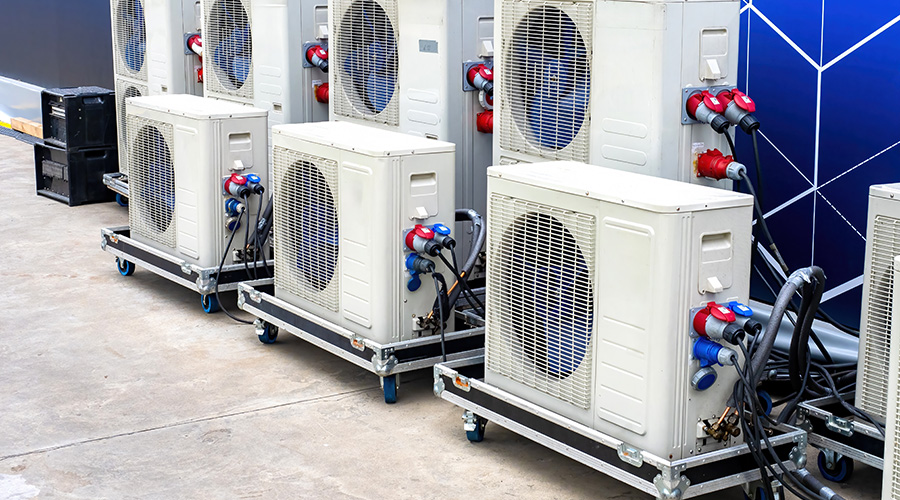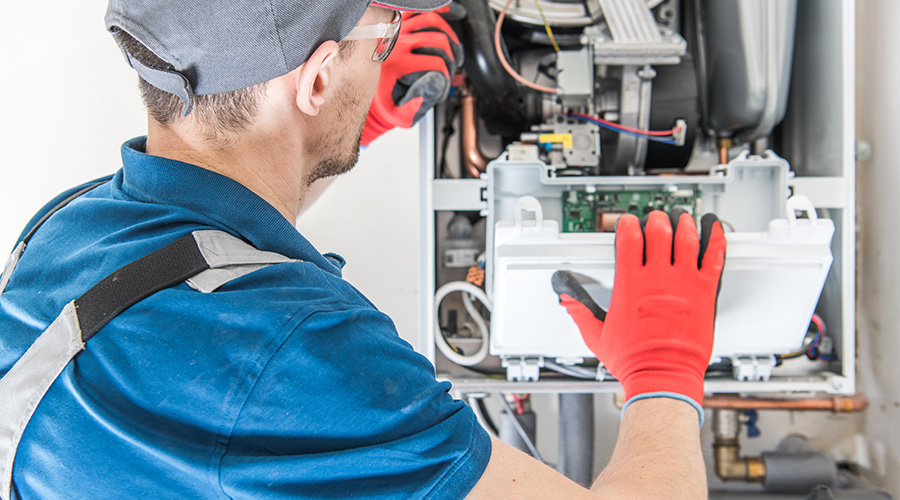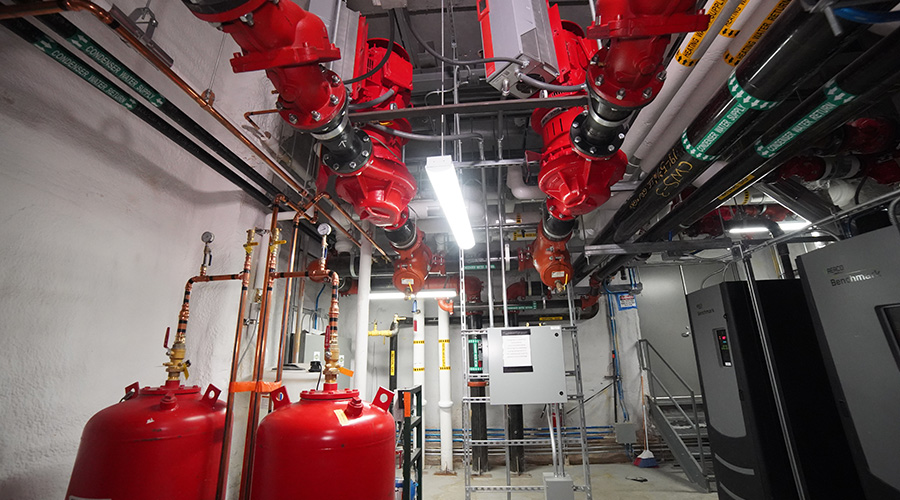Diagnosing HVAC Problems
Technology advances enable managers and technicians to detect problems in systems' operation and ensure their long-term efficiency
Ensuring the efficient operation of institutional and commercial facilities requires a coordinated system of automated diagnostics, interoperable controls, wireless sensors and controls, and integrated HVAC components.
Important technology advances in recent years have created a more powerful array of diagnostic and monitoring tools — both handheld and system-based — that can help engineering and maintenance managers and front-line technicians detect and address small problems in HVAC system operation before they become larger and more expensive.
Technology Advances
Many of these technology advances involve improved communication among manufacturers’ components, subsystems, and building systems and information-technology (IT) services. They have affected the entire spectrum of HVAC system measurements and controls.
The resulting ability to better diagnose and monitor air handlers, chillers, pumps, and variable-air-volume (VAV) boxes is substantially reducing costs. Coupled with use of statistical analysis and system databases, these tools help technicians analyze deviations within operations to pinpoint the root causes and provide solutions so managers can implement the most appropriate solution quickly.
More building automation and control networks also are interoperable with other systems. Managers’ HVAC component choices are no longer limited to proprietary items supplied by the manufacturer of a building management system, as was the case with electro-pneumatic and earlier direct-digital controllers.
Managers also are finding more system interoperability with lighting, access control, security, closed-circuit TV and power monitoring. Now the same interoperable motion sensor can alert:
• the HVAC system to the need for heating or cooling
• the access-control system about an entry request
• the security system to the presence of an intruder
• the fire-alarm system to occupants’ locations
• air handlers and lighting systems to direct the fire and smoke away from occupants and direct occupants toward exits.
In short, one sensor can handle six system outputs. The advances offer more control for users, as well as more selection options and smarter operation for managers, more opportunities for suppliers, and better risk management for owners.
But managers still need to be aware that the failure of one interoperable sensor affects all of the systems’ operations. To ensure the optimum reliability of highly critical functions, managers will need to build in some redundancy.
Building systems and IT services also are becoming more integrated. Transmission control protocol/internet protocol (TCP/IP) is a popular protocol that enables building systems to use IT networks. A web-based front end allows the system administrator to customize each authorized user’s interface so it includes only approved functions. Using just a computer screen and keyboard, technicians can monitor areas or equipment, adjust setpoints, override automatic controls, schedule, analyze trends, and observe alarm status.
Rather than one sensor for several spaces, wireless sensors located in each area are linked to one actuator, creating both better energy efficiency and greater comfort.
As an adjunct to energy management systems’ own building diagnostics, separate, short-term, portable diagnostic and monitoring devices can perform a valuable role. With multi-sensor, multi-metric capability, these units employ several time-calibrated dataloggers installed at multiple points in a system to track trends over a predetermined period.
These devices provide a check against data from a building’s monitoring system and add functionality. For instance, technicians can add enthalpy measurement if it is not available in the economizers. When connected to a computer, the devices also provide efficiency and analysis software access.
New Opportunities
Diagnostic technology manufacturers have put highly advanced capabilities in the hands of managers and their staffs by combining data capture with ability to assess and evaluate information over time, identify variances from normal, isolate the cause, and suggest corrective action.
Compare the traditional temperature controller with new diagnostics. Traditionally, the analog temperature controller measured temperature, charted variations over time, and regulated it via a control valve.
If the temperature suddenly went out of control, an engineer or operator had to detect that it had happened, be knowledgeable enough to troubleshoot the cause, locate the problem — for example, a cracked diaphragm in a steam valve — manually bypass the valve, and control the steam pressure by manually adjusting the valve in the bypass steam line.
And the operator had to find the cause while the process was still out of control. Once the cause was found, the operator had to know how to shut down the valve and operate the bypass valve to control the flow and bring the temperature back within control limits. Many operators did not have the training to troubleshoot the problem and take action to correct the problem during such a crisis.
By contrast, automated diagnostics in seconds can perform all operations without an attendant, up to the point where it displays the recommended corrective action on a computer screen. Depending on the sophistication of the system, it also can correct the problem temporarily, leaving a log of the action for the operator to review later. Finally, it can send a work order to repair the faulty valve during the next scheduled outage.
While the range of capabilities of diagnostic and monitoring devices available today has expanded greatly, all devices are not alike. Some device suppliers focus on sensing and datalogging, while others focus on diagnosis and corrective action. Still others have carved out segments somewhere in between.
Managers can specify needs, and suppliers can combine a unique set of devices to tailor a solution for each individual facility’s HVAC needs.
Diagnostic Applications: 10 Opportunities
On average, 35 percent of the energy costs for most facilities are related to HVAC systems. Here are 10 practical applications of diagnostic and monitoring technology that can produce bottom-line benefits through improvements in energy efficiency.
1. Wiring can represent 20-80 percent of an application’s cost. Tests comparing a single sensor with wireless multi-sensors linked to one actuator saved 17 percent in energy costs and improved comfort by minimizing overheating and overcooling.
2. Adding automated diagnostics to interpret the data and immediately pinpoint corrective action to bring the system under control can reduce response time from the receipt of an out-of-control signal to corrective action.
The diagnostic part of the sequence has improved dramatically. Software that statistically analyzes real-time data compared to expert systems databases can identify probable causes and select the most likely one, often without human intervention. Besides the quicker response, this tactic can be an excellent training tool for HVAC technicians, giving them a better understanding of system dynamics.
Economizers converted to enthalpy controls use more outside air for cooling during a large part of the year. This reduces chiller loads and increases the energy efficiency of the system. Where an economizer might save $2,000 annually with conventional temperature controls, the same system could save more than $3,000 using enthalpy control to regulate outside air use.
3. Consider converting terminal reheat systems to variable-air-volume (VAV) systems. In a 10,000-square-foot medical facility in the Southwest, converting to VAV from constant volume saved 50 percent in chiller energy and 70 percent in heating fuel. In newer high-efficiency cooling towers, use wet-bulb temperature to control fans by adjusting the set point 2 degrees warmer.
4. Replace or tighten worn or loose control linkages that cause dampers to stick open or shut. Then recalibrate controls. Also, install real-time monitors to show trends in cooling system efficiency in kilowatts (kW) per ton.
5. Install excess-air controllers to sample combustion gases and adjust air volume to the burner in order to raise boiler efficiency.
6. Monitor trends in boiler-makeup water to detect leaks in boiler tubes or condensate-return systems.
7. Use an energy audit to look for simultaneous heating and cooling. In a commercial building, replacing a bad air conditioning valve discovered in this manner saved $1,000 per month in lost energy.
8. Raise the thermostat setpoint during the cooling season to achieve 78 degrees dry-bulb temperature and 55 percent relative humidity. This can shave over 10 percent off an energy bill with little discomfort to occupants.
9. Use energy-estimating software to determine optimum, compared to actual, energy cost based on specific building and equipment inventory specifications.
10. Use portable, short-term diagnostic testing to produce savings. In one such test, a 60,000-square-foot, four-story office building had eight 20- to 25-ton rooftop cooling units and zone electric heating. Heating was monitored for zone and ambient temperatures, total power demand, air-stream temperatures, air velocity, pressure, and heater current. Lighting was monitored for lighting current.
Testing revealed that rooftop units operated during unscheduled time. Some units had no working economizer. Heating and cooling were on at the same time. The air-conditioner compressor kicked in when the outside temperature was below 50 degrees. Many unneeded lights remained on at night.
Using the portable diagnostics resulted in a nearly 20 percent savings in HVAC and lighting energy, clear upgrade cost justification, training and skill upgrades for technicians observing standardized diagnostics tests, and the discovery of a low-cost way to perform periodic diagnostics and monitoring in the future.
— Thomas A. Westerkamp
|
Related Topics:











